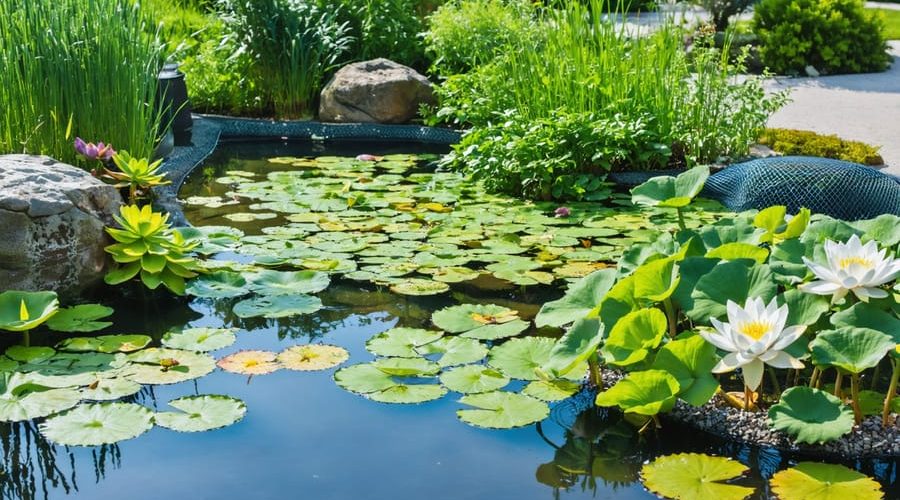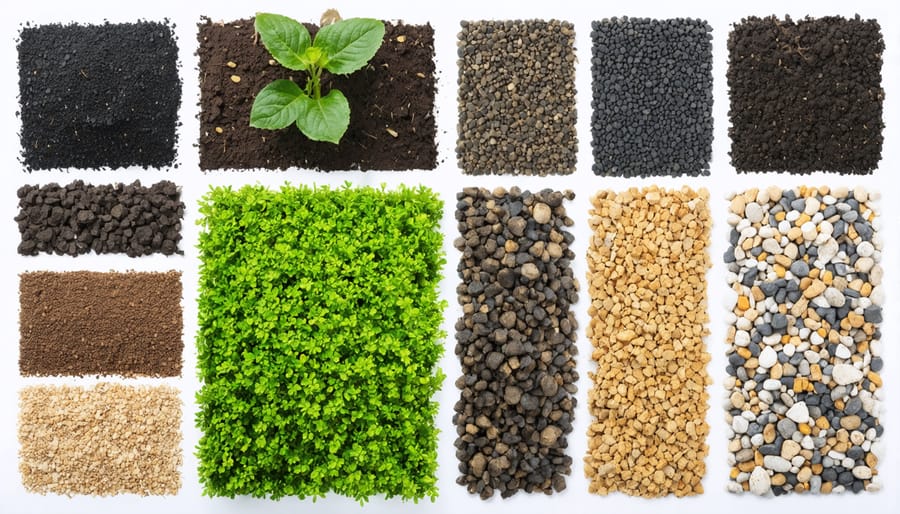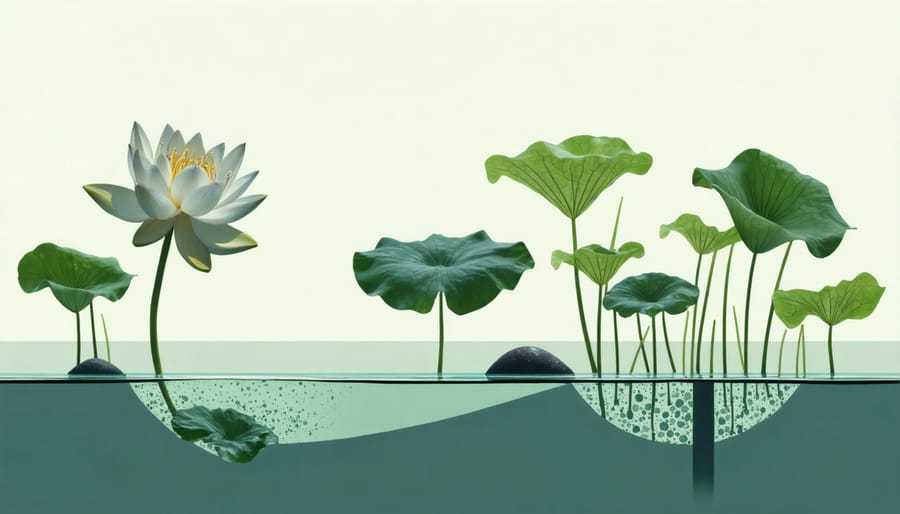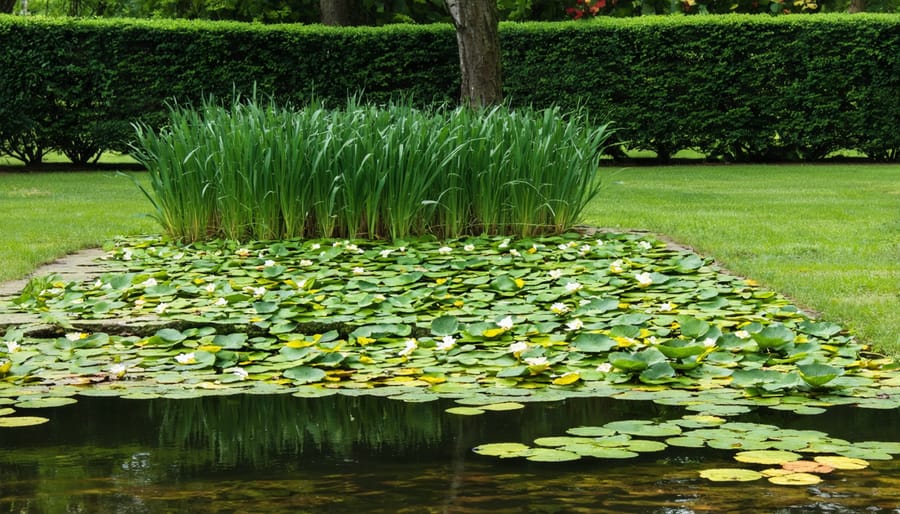
Perfect Pond Plant Growth: Expert Secrets for Choosing and Using Planting Media
Transform your pond’s ecosystem with the right planting media – the foundation of successful natural water garden design. Select clay-based aquatic soil mixes rich in nutrients but free from floating organic matter that could cloud water. Layer coarse gravel over specialized aquatic planting media to prevent soil dispersion while allowing root growth. Position hardy water lilies in deep plastic mesh containers filled with heavy loam soil, topped with pea gravel to anchor plants and maintain water clarity. For marginal plants, combine equal parts aquatic soil and small gravel to create a stable, well-draining environment that promotes healthy root development while preventing nutrient leaching. The right planting media doesn’t just support plant growth – it helps maintain water quality, reduces maintenance needs, and creates the perfect foundation for a thriving water garden ecosystem that delights throughout the seasons.
Understanding Pond Planting Media Basics
What Makes Good Pond Planting Media
Good pond planting media combines several essential characteristics that promote healthy plant growth and maintain water quality. The ideal growing medium should be dense enough to anchor plants securely while allowing roots to spread easily. Look for media that won’t float or break down quickly in water – materials like heavy clay loam or aquatic soil mixes work well.
Nutrient content is crucial but needs careful balance. The best planting media contains enough nutrients to support initial growth without causing algae problems. Many experienced pond gardeners prefer media with moderate fertility levels, as aquatic plants can get additional nutrients from pond water.
Water retention capabilities matter too, but perhaps not in the way you might expect. Unlike garden soil, pond planting media shouldn’t hold too much water, as this can lead to anaerobic conditions that harm root development. Instead, aim for media with good drainage properties that still retain enough moisture when water levels fluctuate.
Texture is another key factor – the media should be coarse enough to allow proper water flow but fine enough to hold plants firmly. A mix of different particle sizes often works best, providing both stability and proper root development conditions.
Common Types of Planting Media
When it comes to pond planting, you’ve got several excellent media options to choose from. Aquatic soil, specially formulated for water gardens, is a popular choice that provides essential nutrients and anchoring for your plants. This nutrient-rich medium closely mimics natural pond bottoms and works particularly well for deep-rooted aquatic plants.
Clay-based media offers fantastic stability and nutrient retention. The small, dense particles help anchor roots while slowly releasing minerals your plants need. Many pond gardeners love using clay-based products because they don’t float or cloud the water like regular garden soil might.
Gravel, ranging from pea-sized to slightly larger stones, is perfect for shallow-water plants and creating natural-looking edges. It’s especially great for water lilies and lotus, as it keeps the soil in place while allowing roots to spread naturally. You can even mix different sizes of gravel to create varied textures and improve drainage.
For best results, many experienced pond gardeners combine these media types, using a base layer of aquatic soil topped with gravel to prevent soil dispersal and create a more stable growing environment.

Matching Media to Plant Types
Marginal Plants
Marginal plants thrive in the transitional zones between water and land, requiring specific media that can retain moisture while providing stability. A mixture of heavy garden soil and aquatic planting media works best, typically in a ratio of 2:1. This combination ensures adequate nutrients while preventing the soil from floating away when submerged.
When creating organic pond layouts, you’ll want to use coarser media near the water’s edge to prevent erosion. Adding a layer of gravel or small rocks on top helps anchor the plants and creates a natural-looking transition between the pond and garden.
For best results, avoid using regular potting soil, as it’s too light and contains organic matter that can foul the water. Instead, opt for clay-based soils mixed with aquatic planting media. This combination provides the weight needed to keep plants anchored while offering proper drainage and aeration for healthy root development. Remember to top off your containers with a 1-inch layer of pea gravel to keep fish from disturbing the soil and maintain water clarity.
Deep Water Plants
Deep water plants like water lilies and lotus require specialized planting media to thrive in submerged conditions. The best choice is typically heavy garden loam or clay-based soil, which helps anchor the plants and provides essential nutrients. Avoid using regular potting soil as it’s too light and will float away, clouding your pond water.
For optimal results, mix your clay-based soil with a small amount of well-aged compost or aquatic plant fertilizer. This creates a nutrient-rich environment that supports healthy root development and abundant blooming. A ratio of about 80% clay soil to 20% organic matter works well for most deep water plants.
When planting, fill your aquatic containers about two-thirds full with this mixture, then top with a layer of pea gravel or small stones. This prevents the soil from floating up and keeps fish from disturbing the planting medium. Remember to avoid limestone-based gravels, as these can alter your pond’s pH levels.
Some experienced pond gardeners also add a small amount of sand to their mix for better drainage within the planting container, though this isn’t essential for success.

Floating Plants
Floating plants offer a unique advantage in pond gardening as they don’t require traditional planting media at all. These plants, such as water lettuce and duckweed, derive their nutrients directly from the water through their roots, which hang freely beneath their floating leaves. Water hyacinths and water lilies can also float initially, though lilies eventually need to be anchored in containers for long-term growth. To help floating plants thrive, simply ensure they have adequate space to spread and protect them from strong winds that might push them to one side of the pond. While they don’t need media, you can use floating rings or gentle netting to keep them positioned in desired areas of your pond, especially during establishment periods.
Artistic Considerations
Color and Texture Coordination
The visual appeal of your pond garden depends significantly on how you coordinate your planting media with the overall design. Different media types offer varying colors and textures that can enhance your pond’s aesthetic appeal. For instance, dark organic media like peat moss can create a striking contrast against lighter-colored plants, while natural gravels add a rustic, earthy feel to your water feature.
When selecting planting media, consider how natural textures in pond design can complement your existing landscape. Light-colored sand or pebbles can brighten up shaded areas, while reddish or brown aggregates work beautifully in sunny spots. Mix different-sized media to create visual interest – combine fine gravel with larger stones to add depth and dimension to your planting zones.
Remember that your chosen media will be visible through clear water, so think about how it will look both above and below the water line. Some gardeners even layer different colored media in clear containers to create an artistic underwater display that adds extra visual interest to their pond design.
Creating Depth and Interest
Creating visual depth in your pond starts with strategic layering of planting media. Begin by establishing a solid foundation using larger gravel or rocks at the bottom, which provides stability and drainage. For mid-level interest, combine different sizes of aquatic planting media to create subtle elevation changes that mirror natural pond beds.
Consider incorporating varied textures and colors of media to enhance visual appeal. Mix dark and light-colored gravels, or combine smooth river rocks with more angular pieces to create contrast. These subtle variations work together with other artistic pond elements to create a more dynamic underwater landscape.
Layer your media to create natural-looking shelves and slopes, perfect for different types of aquatic plants. Place larger stones strategically to create pocket gardens where smaller plants can thrive. Remember to maintain gentle slopes rather than steep drops – this not only looks more natural but also prevents media from sliding down over time.
For added interest, create purposeful gaps between media layers where fish can explore and plants can establish strong root systems. This multi-layered approach not only supports healthy plant growth but also creates an engaging underwater landscape that draws the eye to different depths of your pond.
Installation and Maintenance Tips
Proper Installation Techniques
Proper installation of pond planting media starts with preparing your containers. First, line the bottom of your planting basket with a layer of newspaper or landscaping fabric to prevent the media from seeping out through the holes. This simple step saves you headaches later!
Next, fill your container about one-third full with your chosen planting media. Place your aquatic plant in the center, spreading the roots gently. Continue adding media around the roots until the container is about 80% full, leaving some space at the top for a layer of gravel.
Here’s a pro tip: gently tap the container on a flat surface a few times to help the media settle and eliminate air pockets. This ensures your plants will have stable support as they grow.
Add a 1-inch layer of medium-sized gravel on top of the media. This prevents the media from floating away and creates a neat, finished appearance. When lowering your planted container into the pond, do it gradually at an angle to prevent the media from clouding the water.
For floating plants, use small mesh bags filled with media and secured with plant-safe string. This keeps them anchored at the right depth while allowing for natural movement.
Remember to position your containers at the appropriate depth for each plant species. Most marginal plants thrive with their crown sitting 2-4 inches below the water surface.

Long-term Care and Replacement
To maintain a healthy pond ecosystem, your planting media requires regular attention and occasional replacement. As a general rule, inspect your media every spring and fall for signs of degradation. Most aquatic planting media will need refreshing every 2-3 years, though this can vary depending on your specific setup and plant types.
Watch for these tell-tale signs that it’s time to replace your media:
– Plants showing poor growth or yellowing leaves
– Media becoming too compacted or breaking down into mush
– Foul odors coming from the planting containers
– Water becoming consistently cloudy
– Floating debris from decomposing media
When refreshing your planting media, plan to do so in early spring before the growing season begins. Remove plants carefully, rinse their roots, and trim away any dead material. Dispose of the old media in your garden compost and thoroughly clean the planting containers before adding fresh media.
For ongoing maintenance, gently probe the media surface monthly during growing season to ensure it hasn’t become too compressed. Add a thin layer of fresh media annually to compensate for natural settling. Remove any debris that accumulates on the surface, as this can lead to premature breakdown of the media.
Remember that different plants have varying nutrient needs, so consider incorporating slow-release aquatic fertilizer when refreshing your media to support healthy growth throughout the season.
Creating a thriving pond garden is an exciting journey of discovery, and choosing the right planting media is a crucial part of that adventure. As we’ve explored throughout this guide, there’s no one-size-fits-all solution when it comes to pond planting media – each option brings its own unique benefits to your water garden.
Remember that success often comes through experimentation. Don’t be afraid to try different combinations of media to find what works best for your specific plants and pond conditions. Whether you opt for the traditional approach with heavy topsoil, the convenience of aquatic planting baskets filled with clay-based media, or the natural appeal of gravel and sand mixtures, each choice will influence how your plants grow and thrive.
Keep in mind the key factors we’ve discussed: adequate nutrients, proper anchoring support, and good drainage capabilities. Start with small trials of different media types, observe how your plants respond, and adjust accordingly. You might find that certain plants perform better in specific media, leading you to create a diverse and vibrant pond ecosystem.
The beauty of pond gardening lies in its flexibility and room for creativity. As you gain experience, you’ll develop your own preferred methods and combinations. Don’t forget to share your successes and lessons learned with fellow pond enthusiasts – there’s always something new to discover in the wonderful world of water gardening.
